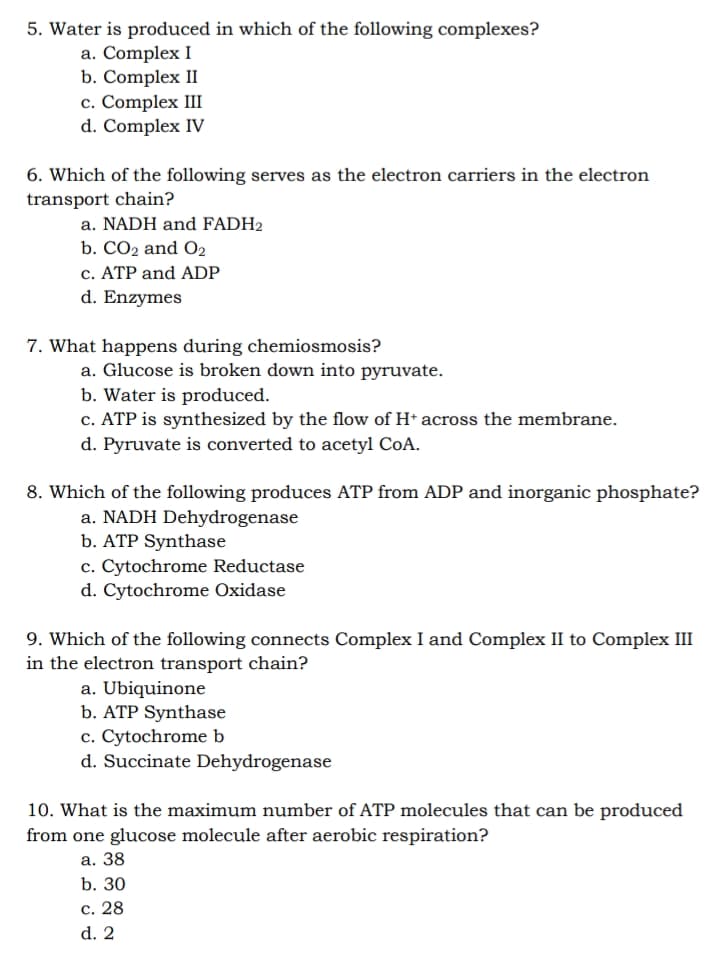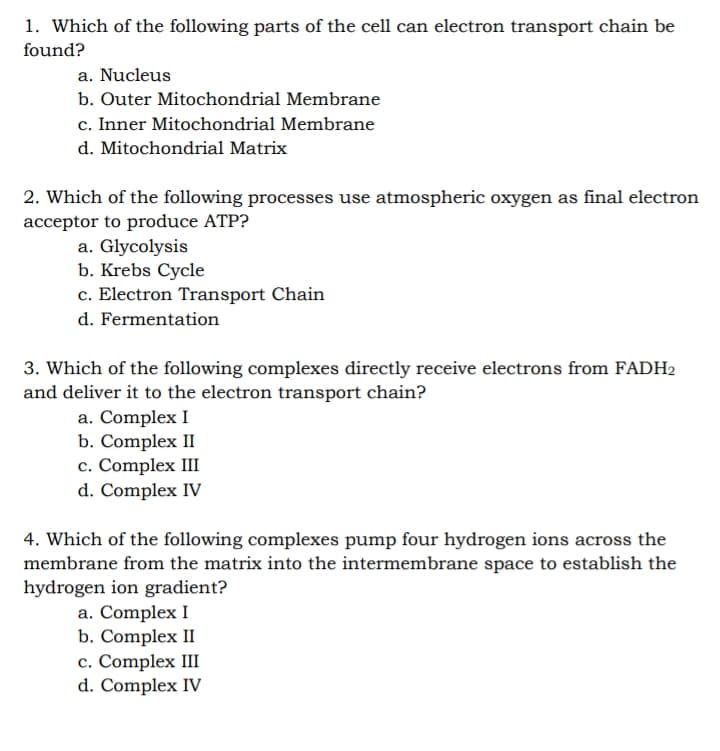5. Water is produced in which of the following complexes? a. Complex I b. Complex II c. Complex III d. Complex IV 6. Which of the following serves as the electron carriers in the electron transport chain?
5. Water is produced in which of the following complexes? a. Complex I b. Complex II c. Complex III d. Complex IV 6. Which of the following serves as the electron carriers in the electron transport chain?
Biology: The Dynamic Science (MindTap Course List)
4th Edition
ISBN:9781305389892
Author:Peter J. Russell, Paul E. Hertz, Beverly McMillan
Publisher:Peter J. Russell, Paul E. Hertz, Beverly McMillan
Chapter7: Cellular Respiration: Harvesting Chemical Energy
Section: Chapter Questions
Problem 3TYK
Related questions
Question
part 5

Transcribed Image Text:5. Water is produced in which of the following complexes?
a. Complex I
b. Complex II
c. Complex III
d. Complex IV
6. Which of the following serves as the electron carriers in the electron
transport chain?
a. NADH and FADH2
b. CO2 and O2
c. ATP and ADP
d. Enzymes
7. What happens during chemiosmosis?
a. Glucose is broken down into pyruvate.
b. Water is produced.
c. ATP is synthesized by the flow of H* across the membrane.
d. Pyruvate is converted to acetyl CoA.
8. Which of the following produces ATP from ADP and inorganic phosphate?
a. NADH Dehydrogenase
b. ATP Synthase
c. Cytochrome Reductase
d. Cytochrome Oxidase
9. Which of the following connects Complex I and Complex II to Complex III
in the electron transport chain?
a. Ubiquinone
b. ATP Synthase
c. Cytochrome b
d. Succinate Dehydrogenase
10. What is the maximum number of ATP molecules that can be produced
from one glucose molecule after aerobic respiration?
а. 38
b. 30
с. 28
d. 2

Transcribed Image Text:1. Which of the following parts of the cell can electron transport chain be
found?
a. Nucleus
b. Outer Mitochondrial Membrane
c. Inner Mitochondrial Membrane
d. Mitochondrial Matrix
2. Which of the following processes use atmospheric oxygen as final electron
acceptor to produce ATP?
a. Glycolysis
b. Krebs Cycle
c. Electron Transport Chain
d. Fermentation
3. Which of the following complexes directly receive electrons from FADH2
and deliver it to the electron transport chain?
a. Complex I
b. Complex II
с. Complex I
d. Complex IV
4. Which of the following complexes pump four hydrogen ions across the
membrane from the matrix into the intermembrane space to establish the
hydrogen ion gradient?
a. Complex I
b. Complex II
c. Complex III
d. Complex IV
Expert Solution
This question has been solved!
Explore an expertly crafted, step-by-step solution for a thorough understanding of key concepts.
This is a popular solution!
Trending now
This is a popular solution!
Step by step
Solved in 2 steps

Knowledge Booster
Learn more about
Need a deep-dive on the concept behind this application? Look no further. Learn more about this topic, biology and related others by exploring similar questions and additional content below.Recommended textbooks for you

Biology: The Dynamic Science (MindTap Course List)
Biology
ISBN:
9781305389892
Author:
Peter J. Russell, Paul E. Hertz, Beverly McMillan
Publisher:
Cengage Learning

Biology: The Unity and Diversity of Life (MindTap…
Biology
ISBN:
9781337408332
Author:
Cecie Starr, Ralph Taggart, Christine Evers, Lisa Starr
Publisher:
Cengage Learning


Biology: The Dynamic Science (MindTap Course List)
Biology
ISBN:
9781305389892
Author:
Peter J. Russell, Paul E. Hertz, Beverly McMillan
Publisher:
Cengage Learning

Biology: The Unity and Diversity of Life (MindTap…
Biology
ISBN:
9781337408332
Author:
Cecie Starr, Ralph Taggart, Christine Evers, Lisa Starr
Publisher:
Cengage Learning


Biology (MindTap Course List)
Biology
ISBN:
9781337392938
Author:
Eldra Solomon, Charles Martin, Diana W. Martin, Linda R. Berg
Publisher:
Cengage Learning

Biology: The Unity and Diversity of Life (MindTap…
Biology
ISBN:
9781305073951
Author:
Cecie Starr, Ralph Taggart, Christine Evers, Lisa Starr
Publisher:
Cengage Learning